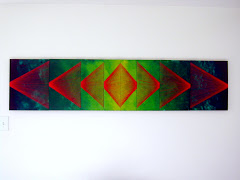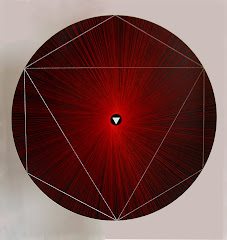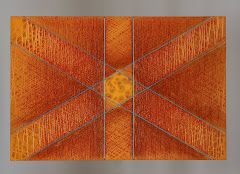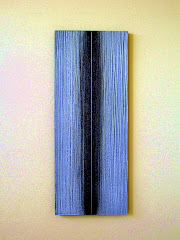Preface - It's been more than a year since I contingently finished the blog series "My Significant Other is the Kosmos", initiated as an accompaniment to a then impending solo exhibition. Now a new, more far reaching exhibition looms this coming August, and the urge to start a dialogue has grabbed me by the throat (or the balls, if you will) once again. It seems that, once one has declared the Kosmos as Significant Other, divorce is not an option. So bear with me and we'll see where this tunnel of love is headed...
There's a thorny question that can present itself when one is faced with a blank canvas, or page, or computer screen (or for that matter, a blank mind) - that is, what is there to paint, write, or think about that is worthy, or - dare I say it - good. For some this becomes a question posed in the inner mind by the specter of a teacher, or critic, or friend, or parent. There was an old TV show comedian who used to exclaim, whenever someone started telling him what to do, "Here comes da Judge! Here comes da Judge!"; and like a stern judge peering down with squinty eyes from a high bench, that inner voice can be downright threatening. Or like those wacky nocturnal dreams where you suddenly notice you've been going about your affairs in public with no pants on, the voice can throw you into panic. From this perspective the question of worthiness, or the good, can initiate a cramp in the muscles of the creative process, a self-conscious constriction of creative energy, a deflating of élan vital. In short, a block. For this reason many simply choose to ignore this question of the good altogether, and I will concur that if it's "Here comes da Judge" it is indeed "There goes da Muse".
But I would like to point to a deeper aspect of the question regarding worthiness or the good, one that looks well beyond external judgments terrestrial or celestial, real or imagined. When facing a blank page or canvas, one must ultimately ask from the most authentic self available, from the deepest regions of the soul if you will, what it is that is truly good to create, and how is the creative process being engaged in oriented to that good. From that perspective the question is a profoundly moral one - not in the ethical sense, as in "what should I do?", but in the moral identity sense, as in "Who am I, why am I here, what am I doing here?" (and perhaps just as importantly, "Who are we, why are we here, what are we doing here?").
So I am proposing -, with the full knowledge that many will run in terror at the prospect, while others will snicker behind their hands - that the creative process has a deeply moral dimension, one that is unavoidable whether the creative agent is conscious of it or not. And I'll propose that if one is willing to look at the creative process through this lens - if one is willing to mine the creative possibilities and energy inherent in what I'll call "moral sources" - then new and unexpected doors will open. And, "Da Judge" will not be behind any of them.
So I can imagine those of you who have read last year's telling of my odd story are wondering what "moral sources" has to do with possible Kundalini awakening and its consequences. I certainly am! I think one of the keys just might lie in what the philosopher Charles Taylor calls "webs of interlocution".
But that is to be continued...
Saturday, June 15, 2013
Subscribe to:
Comments (Atom)





.jpg)